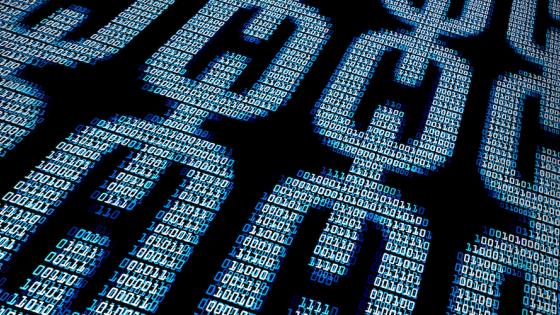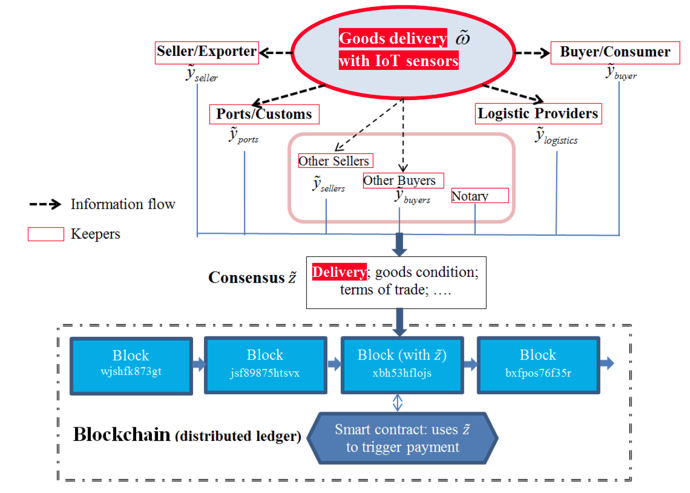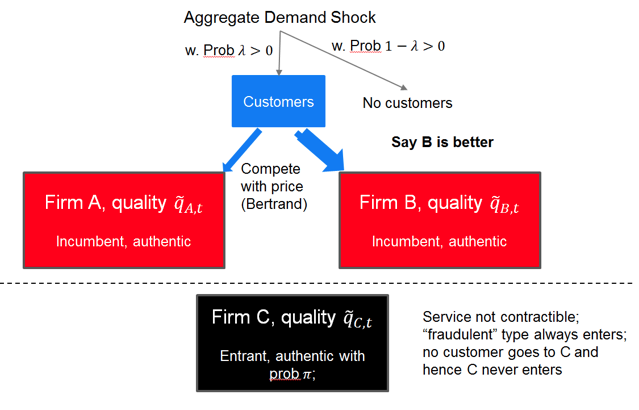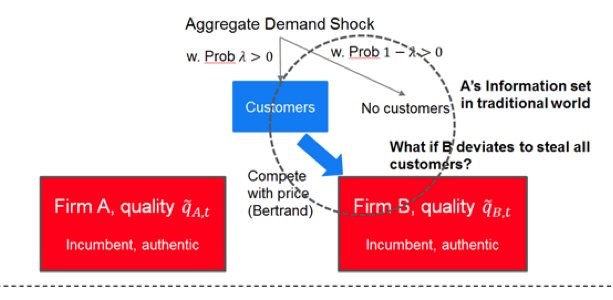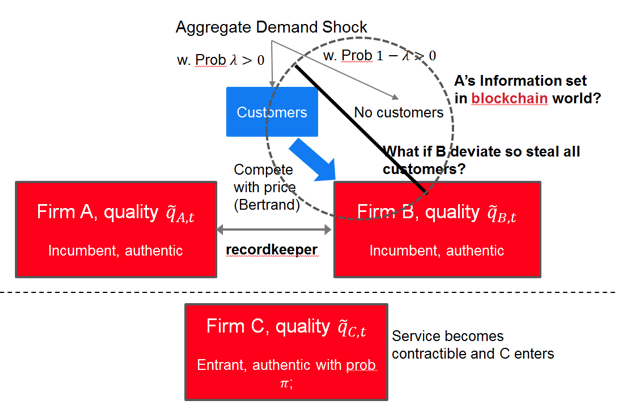Blockchain is a distributed ledger technology, first popularised through the cryptocurrency Bitcoin. It has since emerged in other forms, creating smart contracts in which payments are triggered by tamper-proof consensus on contingent outcomes, and financing startups through initial coin offerings (ICOs). The market capitalisation of blockchain-based cryptocurrencies peaked at $800 billion in 2017. In 2017, Blockchain-based ICOs were a larger source of financing for platform startups than venture capital.
There is still debate on what exactly a blockchain is, and how its applications should be regulated. Stuart Haber and W. Scott Stornetta, two cryptographers, were working on blockchain in 1991. Its simplest form uses a distributed database that autonomously maintains a continuously growing list of public transaction records in units of 'blocks', secured from tampering by time-stamping and encrypted hash links. Bitcoin's innovation (Nakamoto 2008) was to combine the innovations of computer scientists in consensus algorithms, and the idea of digital cash (Narayanan and Clark 2017). Bitcoin maintains a distributed consensus record of past transactions, which effectively solves the 'double spending' problem of digital cash.1 At the same time, bitcoins as cryptocurrencies provide incentives under the Proof-of-Work protocol so that miners have the right incentives to maintain the consensus.2
Economists have long recognized that consensus enables the proper functioning of society, including ethics, contracting, and legal enforcement, among others. Compared to traditional systems, this consensus is generated and maintained in a more decentralised manner. Advocates of blockchain believe this can improve the resilience of the system, and reduce the rent extracted by centralised third parties. Many also believe that the technology potentially disrupts businesses in the way the internet disrupted off-line commerce, but others are sceptical of its genuine innovation and real-world applicability, not to mention its association with money laundering and drug dealing.3
Economically relevant areas of research into blockchain
There are two areas of interest:
- Mechanisms for generating and maintaining 'decentralised consensus'. This is a description of the state of the world that is universally accepted and acted upon by all agents.4 Analysing the process of consensus generation may emphasise the tradeoffs in decentralisation and incentive provision (for example, Kroll et al. 2013, Saleh 2018, and Biais et al. 2018), or study market organisations, typically drawing evidence from the Bitcoin blockchain.
- The real-world implications of the functionality blockchain provides. These include impacts on market transparency (Malinova and Park 2017), cryptocurrency valuation (Cong et al. 2018a), initial coin offerings (Li and Mann 2018, Cong and Li 2018), auditing (Cao et al. 2018), and smart contracts (Bartoletti and Pompianu 2017).
Emphasising the role of information, we have contributed to both areas of interest by offering a holistic analysis on the tradeoffs in providing blockchain’s core functionality (Cong and He 2018).
We argue that the technology’s various incarnations share a core functionality in providing decentralised consensus, but there is afundamental tension between decentralised consensus and information distribution in blockchain applications.
Empirically, this fundamental tension has been recognised by governments, media, and industry research. For example, Project Jasper at the Bank of Canada revealed that:
"[M]ore robust data verification requires wider sharing of information. The balance required between transparency and privacy poses a fundamental question to the viability of the system for such uses once its core and defining feature is limited.”5
The applications of blockchain technology and smart contracts are broad. Many have gone beyond merely proofs of concept. Blockchain-based peer-to-peer payments are the best-known examples. Bitcoins, Lightning, Ripples, LITEX, and others make value transfers on decentralised networks possible, without relying on trusted third parties (for a summary, see Cong and He 2018).
In particular trade finance, an industry with a $10 trillion annual volume, is suitable for blockchain applications, with the help of 'oracles' – feeders of information from the offchain world and the internet of things (IoT). Large institutional players or consortiums such as Barclays, IBM, Walmart, and R3 CEV have all developed their own trade finance blockchains. The first global trade transaction, shipping butter and cheese between Ornua and Seychelles, was completed in 2016.
Decentralised consensus and information distribution
Consider a trade finance example. International exporters (sellers) of goods often need to ship their goods with proper care (say, wine, for which the temperature is critical). To successfully sell these goods to importers (customers), they need other parties: logistics providers, international ports, customs, notaries, and financing intermediaries.
Let us consider a delivery outcome (denoted by omega in Figure 1). The physical condition of the goods can be monitored using IoT technologies that make end-to-end information collection possible. Even without the help of IoT, other customers who collect other goods at the same port may observe relevant information on this delivery.
Consider this example of a seller delivering goods to a buyer and the delivery outcome is uncertain (denoted by omega in Figure 1). Record-keepers, potentially with real-time IoT sensors, monitor the delivery and submit their reports. The protocol of blockchain aggregates these reports to form a decentralised consensus
Figure 1 Trade-finance example on blockchain
A new block is then added to the chain, as shown in the bottom of the figure. This newly created block must pass consistency checks with respect to the existing blockchain. The history of the existing blockchain can be thought of incorporating past reports as an input for generating current consensus and must pass consistency checks before more blocks are added to it. This thematic treatment covers the case where the added block still requires further verification, as in the case of Bitcoin, so 'added' in this context implies 'finalised' or 'confirmed'. The system keeps adding these decentralised consensuses, contained in blocks, at regular intervals. This establishes a sequence that is accepted by all participating agents.
This generates a decentralised consensus on delivery outcome. Essentially, blockchain aggregate information from many relevant parties, reaching a consensus that can be accepted by the community. This is done by contacting verifiers on the blockchain, or record-keepers – for example the seller-buyer pair, logistics providers, and ports, who might not truthfully report. Figure 1 also illustrates this process.
In general, blockchains interact with dispersed record keepers to reach a decentralised consensus. Similar to third-party arbitrators or witnesses in the traditional economy, they receive signals on the true state of the world, and may have incentives to tamper with those signals, or manipulate them. With the help of fast-developing real-time communication technologies, blockchains can mitigate individual misreporting incentives, allowing for better information aggregation and more efficient contracting. Nevertheless, to generate a more effective consensus, decentralised record-keepers need to be able to observe and receive greater amounts of information.
Consequently, blockchain applications feature a fundamental tension between decentralised consensus and information distribution. The impact on welfare and consumer surplus can be ambiguous.
The impact of blockchain on industrial organisation
Armed with this insight, we analysed the impact of blockchain technology on industrial organisation. Consider a market with two authentic incumbent sellers (Firm A and Firm B), and an entrant firm C. They sell goods with different qualities, and the entrant firm C might not be able to deliver the goods, or it might be fraudulent. Customers arrive randomly with some probability lamda, representing an aggregate demand shock similar to that in Green and Porter (1984).
In the traditional world, with incomplete contracts, sellers often cannot offer prices contingent on the success of delivering the goods. The lemons problem thus precludes entry. Figure 2 shows this.
In the figure, the aggregate demand shock is customers showing up with probability lamda. Because the entrant seller, Firm C, has not established its reputation, it is believed to be authentic only with probability pi. The lack of contractibility on outcomes makes customers unwilling to buy from firm C, even though C’s quality could be higher than firms A and B. The lack of entry is anti-competitive.
Figure 2 Traditional world: Lack of entry
Meanwhile, incumbents cannot differentiate an aggregate demand shock from the event of a rival seller stealing market share, making collusion relatively hard to sustain, as illustrated below (Figure 3).
Figure 3 Traditional world: Dynamic equilibria
Incumbents A and B may sustain collusion by dynamically punishing deviations from the collusive prices. What if Firm B deviates, though? Firm A’s information set does not allow it to distinguish the aggregate shock (no customers) from Firm B’s deviation. This makes a punishment less accurate, and collusion harder to sustain.
Blockchains, using decentralised consensus, make it possible for agents to write smart contracts with contingencies on delivery outcomes and automate contingent transfers. This allows the (authentic) entrant firm C to compete in the market to enhance welfare and consumer surplus, as we can see in Figure 4. With blockchain-based smart contracting, Firm C can now offer to charge a price only if it is proven to be authentic. Fraudulent entrants then have no incentive to mimic authentic firms. This allows authentic entrants to enter the market, enhancing competition, increasing welfare and consumer surplus.
Figure 4 Blockchain world: Entry due to smart contracting
But generating decentralised consensus also inevitably leads to greater information distribution. Better knowledge about aggregate demand shocks enables sellers to more accurately punish deviations from tacit collusion. This fosters anti-competitive market outcomes, as we see in Figure 5.
Figure 5 Blockchain world: Enhanced collusion due to information distribution
In Figure 5, when Firm A does not receive customers, it knows whether there is no customer in aggregate, or all customers are buying from Firm B. This is because Firm A serves as the recordkeeper. Hence the distribution of information to generate decentralised consensus for smart contracting reveals any aggregate demand shock to Firm A. Consequently, a firm involved in collusion can more accurately punish deviation behaviour, and so is better at sustaining any collusion.
More generally, using blockchain and smart contracts, the set of possible dynamic equilibria expands. This leads to social welfare and consumer surplus that could be higher or lower than in a traditional world.
Empirical evidence suggests that greater information sharing facilitates collusion (Bourveau et al. 2017). There is widespread concern that blockchains may jeopardise market competitiveness, and our findings highlight one salient mechanism through which blockchain makes collusion easier. This becomes especially relevant for permissioned blockchains with powerful financial institutions as exclusive members (Kaminska 2015).
Conclusion and looking forward
We have been able to demonstrate that blockchains are not merely database technologies that reduce the cost of storing or sharing data. The design of the blockchain can have additional profound economic implications on consensus generation, industrial organisation, smart contract design, and anti-trust policy. Blockchains, while holding great potential in mitigating information asymmetry and encouraging entry, can also lead to greater collusive behaviour.
Our study has several policy implications. For instance, a neglected regulatory solution would be to separate usage and consensus generation on blockchains, so that sellers cannot use the consensus-generating information for the purpose of sustaining collusion. Introducing regulatory nodes, or encouraging platform competition, might also be options. The natural next step would be to bring mechanism and information design into the study of blockchain economics.
References
Bartoletti, M, and L Pompianu (2017), “An empirical analysis of smart contracts: platforms, applications, and design patterns”, in Financial Cryptography and Data Security, Springer International Publishing.
Biais, B, C Bisiere, M Bouvard, and C Casamatta (2018), “The Blockchain Folk Theorem”, Toulouse School of Economics working paper 17‐817.
Bourveau, T, G She, and A Zaldokas (2017), “Naughty firms, noisy disclosure: The Effects of Cartel Enforcement on Corporate Disclosure”, working paper.
Cao, S, L W Cong, and B Yang (2018), “Auditing and Blockchains: Private Information, Mis-statement Risk, and Auditor Independence”, work in progress.
Cong, L W, and Z He (2018), “Blockchain Disruption and Smart Contracts”, Review of Financial Studies, forthcoming.
Cong, L W, Z He, and J Li (2018b), “Decentralized Mining in Centralized Pools”, working paper.
Cong, L W, Y Li, and N Wang (2018a), “Tokenomics: Dynamic Adoption and Valuation”, working paper.
Cong, L W, and Y Li (2018), “Tokenomics: Coin Offerings, Business Acceleration, and Frauds”, work in progress.
De Vilaca Burgos, Aldenio and de Oliveira Filho, Jose Deodoro and Suares, Marcus Vinicius Cursino and de Almeida, Rafael Sarres (2017), “Distributed Ledger Technical Research in Central Bank of Brazil”, working paper
Economist, The (2015), "The Trust Machine", 31 October.
Gillis, M and Trusca, A (2017), “Not There Yet: Bank of Canada Experiments with Blockchain Wholesale Payment System", McCarthy Tétrault.
Halaburda, H, and M Sarvary (2016), Beyond Bitcoin: The Economics of Digital Currencies, Palgrave Macmillan.
Harvey, C (2016), “Cryptofinance”, working paper.
Jeffries, A (2018), "Blockchain is meaningless", The Verge, 7 March.
Kaminska, I (2015), "Exposing the 'If we call it a blockchain, perhaps it won’t be deemed a cartel?' tactic", FT Alphaville, 11 May.
Kroll, J A, I C Davey, and E W Felten (2013), “The Economics of Bitcoin Mining, or Bitcoin in the Presence of Adversaries”, The Twelfth Workshop on the Economics of Information Security, Washington, DC, 11-12 June.
Li, J, and W Mann (2018), “Initial Coin Offerings and Platform Building”, working paper.
Malinova, K, and A Park (2018), “Market Design for Trading with Blockchain Technology”, working paper.
Nakamoto, S (2008), “Bitcoin: A Peer-to-Peer Electronic Cash System”, Bitcoin.org.
Narayanan, A, and J Clark (2017), “Bitcoin’s Academic Pedigree”, Communications of the ACM60: 36-45.
Saleh, F (2018), “Blockchain without Waste: Proof-of-Stake”, working paper.
Stinchcombe, K (2017), "Ten years in, nobody has come up with a use for blockchain", Hackernoon.com, 22 December
Yermack, D (2017), “Corporate Governance and Blockchains,” Review of Finance, forthcoming.
Endnotes
[1] Double-spending is a potential flaw in a digital cash system. The same digital currency can be spent more than once when there is no consensus record of transaction histories. This is because the digital file that it consists of can be duplicated or falsified.
[2] Other forms of blockchain have emerged subsequently with different designs affecting exclusivity, transparency, and maintenance of the records. Halaburda and Sarvary (2016), Harvey (2016), and Yermack (2017) provide introductions to the basics of blockchain.
[3] See Economist (2015), which argues that 'the technology behind bitcoin could change how the economy works". Marc Andreessen, the co-creator of Netscape, says: 'This is the thing! This is the distributed trust network that the Internet always needed and never had.' On the negative side, see Narayanan and Clark (2017). Jeffries (2018) and Stinchcombe (2017) raise doubts about the practical applications of blockchain.
[4] Blockchains provide many other functions, such as distributed data storage, anonymity, data obfuscation, shared ledgers, and so on. Because there are well-known solutions to these problems outside the blockchain space, its impact along these dimensions, though material, is somewhat incidental.
[5] See Gillis and Trusca (2017). Chapman et al. (2017), and de Vilaca Burgos et al. (2017), who also emphasise this point.
